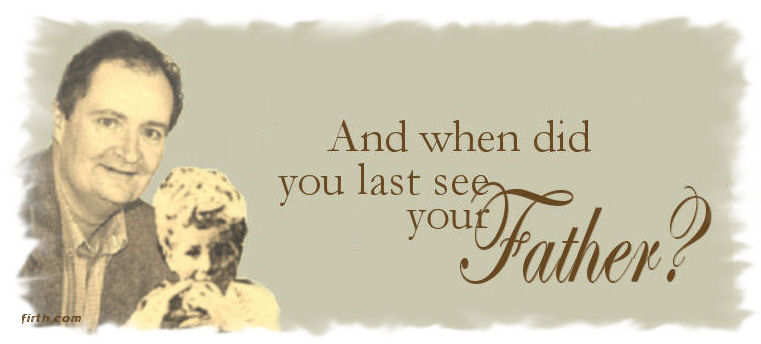

Short Synopsis
When Did You Last See Your Father? is an unflinching exploration of a father/son relationship, as Blake Morrison deals with his father Arthur’s terminal illness and imminent death. Blake’s memories of everything funny, embarrassing and upsetting about his childhood and teens are interspersed with tender and heartrending scenes in the present, as he struggles to come to terms with his father, and their history of conflict, and learns to accept that one’s parents are not always accountable to their children.
Directed by Anand Tucker (Hilary and Jackie), from a screenplay by David Nicholls, adapted from Blake Morrison’s novel of the same name, the film stars Colin Firth, Jim Broadbent, Juliet Stevenson, Gina McKee, Claire Skinner, and Matthew Beard.
Long Synopsis
Arthur Morrison (Jim Broadbent), and his wife Kim (Juliet Stevenson), are doctors in the same medical practice in the heart of the Yorkshire Dales, England. They have two children, Gillian (Claire Skinner), and her older brother Blake (Colin Firth) Blake is a forty-year-old established author, married with two children and confronted with the fact that his father is terminally ill.
The film opens during a summer family trip in the late 1950s. Arthur hits the hard shoulder to skip a long queue of traffic at a car racing event, and eight-year-old Blake and the rest of the family, are overwhelmingly embarrassed. It’s the first of many flashbacks that illustrate Arthur’s bluff attitude to life and his pride in getting something for nothing. These childhood episodes also introduce Beaty (Sarah Lancashire) and her daughter, Josie. It soon becomes clear that Beaty and Arthur are more than just friends and that Josie is potentially Arthur’s child. Adult Blake strives to find out the truth about Josie, and in doing so uncovers the interesting parameters of his father’s marriage.
The essence of this father and son relationship is further explored through flashbacks to Blake’s teens—a family holiday, a fumbled affair with the au pair—where the awkward and introverted Blake is constantly crushed by his father’s flirtatious ways and need to be the center of attention. There are happy and tender memories too; of Arthur teaching Blake to drive, a camping trip in the rain, and Arthur saying goodbye to Blake as he leaves for university. In the present it becomes clear that Arthur still dominates his grown-up son, a dynamic to which Blake is resigned, much to his wife Kathy’s (Gina McKee) annoyance. When he and his family confront the reality of Arthur’s cancer, Blake is forced to reconcile himself with the past. Blake’s recollections are interspersed with heart-rending and uncompromising scenes of Arthur’s decline and submission to the disease that is killing him. It is ironic that Arthur’s battle with his failing health is paralleled by Blake’s struggle to come to terms with their relationship, but there’s a human inevitability we can all identify with. It is only after Arthur’s death; only when the tears come, that Blake is finally able to make peace with his memories.
The Production
First published in 1993, Blake Morrison’s And When Did You Last See Your Father? is an extraordinary portrait of family life, and an honest and moving account of his father’s life and death. It became a best seller, winning both the J R Ackerley Prize and the Esquire/Volvo/Waterstone’s Non-Fiction Book Award, and inspiring a whole genre of confessional memoirs.
Blake Morrison explains: “I never imagined that I would write a book about my father but when he became ill, I was in such a state of shock, I found myself keeping diary entries as a way of dealing with it. As I wrote, I started to recover childhood memories, which proved to be therapeutic in coming to terms with my father’s death. I showed the diary entries to somebody who thought they might interest people, and so something that was very private to begin with, eventually became a book.”
The power of the story lies in its extreme candor, a characteristic which Blake acknowledges may not have existed had he not written the book when his father was dying. He explains: “My normal censorship rules weren’t in place. I was so disorientated by what was happening, it all spilled out.”
When producer Elizabeth Karlsen read the book, it completely captivated her: “I thought it was absolutely wonderful, a really beautiful book, and a universal story that would work very well on screen,” says Elizabeth. Unfortunately, she was to discover the book had already been optioned. “I thought that was the end of the story,” says Elizabeth. However, some time later, Elizabeth began to wonder what had happened to the book. “With things that get under your skin,” she says, “you can’t help but return to them”. To her delight, she discovered that the option had lapsed, and together with veteran producer Stephen Woolley, snapped up the option on the spot for their company Number 9 Films.
Their first move was to ask David Nicholls, writer of Cold Feet, to write the screenplay. He had read the book when it was first published, some ten years before, and was gripped by its raw honesty. He had long since harbored a desire to adapt the book for the screen.
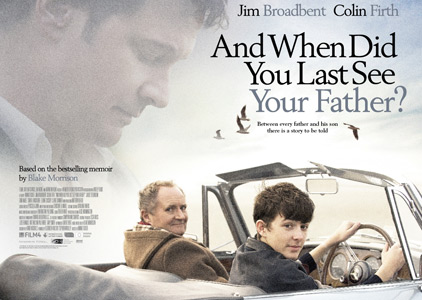 Says
David: “I found the book to be incredibly moving. It dealt with a
subject that had seldom been dealt with before, with so much honesty,
and frankness, and detail. I’m in awe of Blake’s ability to be that
emotionally honest. He really ‘spilled his guts’ in the book. It’s what
makes it so compelling.”
Says
David: “I found the book to be incredibly moving. It dealt with a
subject that had seldom been dealt with before, with so much honesty,
and frankness, and detail. I’m in awe of Blake’s ability to be that
emotionally honest. He really ‘spilled his guts’ in the book. It’s what
makes it so compelling.”The writer and the producers, however, were well aware of the difficulties of adapting this particular book into a script. Although it has a remarkable relationship at its center, the story is very impressionistic and episodic, and does not lend itself naturally to a narrative. Explains David: “The problem with adapting a memoir for the screen is that real life tends not to follow the ark of a film—a beginning, middle, and end. The biggest challenge has been staying true to the contents of the book whilst imposing the shape on it, and wheedling out details which will work well on screen.”
David continues: “In the film, we’re trying to replicate the sense you get of the process Blake goes through as he writes the memoir—at the beginning maddened by his father’s self-righteousness, by his pomposity, by him constantly hogging the limelight, towards a coming to terms with all of those qualities and finally finding peace with the memory of his father, and that in spite of his exasperating qualities, he was a compelling and attractive man. What’s extremely moving about the book, and what I hope we’ve achieved in the adaptation, is Blake’s journey from resenting his father to embracing his memory, and that is a very powerful journey.” “Although it’s tragic that the father dies, and that Blake experiences such loss and such confusion in his grief,” observes Elizabeth, “it is also a real celebration of a life—and a relationship.”
With a script in the works, the producers turned their attention to finding the right director for the project, and found they shared a common vision for the film with director Anand Tucker. “It really moved me, and I wanted to do it. It was a simple as that,” recalls Anand. “It was one of those rare lightening strikes moments… David had written a very beautiful script that was also funny, touching, and tender. There’s something very compelling about real life, and the way Blake was so honest about what happens to you when someone’s dying. It was essential to preserve that truthfulness, and hopefully it will allow an audience to experience their own emotions through the filter of the character, and move them without them feeling exploited.”
Says Elizabeth: “We approached Anand to direct the film because we felt he was a perfect fit for the material. He showed with the brilliant Hilary and Jackie how capable he is of handling intimate, emotional narrative without making the story feel small or the images mundane. He is a real filmmaker, who can take a personal story and raise it to great visual and emotional heights.”
Coming at the project with his own enthusiasm and perspective, Anand worked alongside David to shape the shooting script. Says David: “Anand embraced the material in a sensitive and poetic way.” Blake was assured of Anand’s dedication to authenticity by his many probing questions. Blake remarks: “I have a great deal of respect for Anand Tucker as a director. He had questions about things not in the book because he wanted to get it right. I had to accept that a film and book are different creatures, and that the film has to work in a different way, but I trusted Anand from an early stage that he would find an equivalent form of expressing both the humor and sadness. I knew that he would be attentive to the emotional power of the material. What’s specific to me and my family isn’t that important, what’s crucial is to convey the elemental things about relationships in a family, and I’m absolutely sure the film will honor that.”

The Morrison Family
At the center of the story is an unflinching portrait of a father and son relationship. Blake sheds light on Arthur Morrison, and their relationship: “I loved my father, but he was a difficult man. He was overbearing and the rest of the family, me, my mother, and my sister, lived in his shadow. He was however a larger than life character and very charismatic.” He continues: “Many fathers want their sons to follow in their footsteps and that was certainly true of my father. It was his dream that I would take over the family practice. Unfortunately I had no interest in being a doctor so I disappointed him. At the same time, when he saw that I was doing quite well in my chosen field as a writer, I believe there was some pride.”
In the pivotal roles of Blake Morrison, the son, and Arthur Morrison, the father, the filmmakers were lucky enough to secure the services of their first choice for both roles, two of Britain’s finest actors, Colin Firth and Jim Broadbent. Says Elizabeth: “Our hope was that because the script was so powerful and Anand such a talented director, this would be a project that they couldn’t say no to… We were thrilled that they both wanted to do it.”
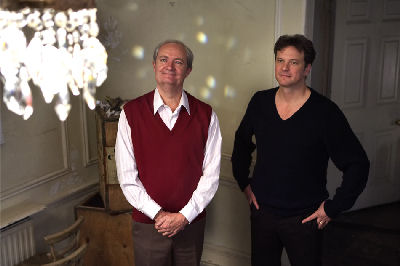 “I
saw a story which was simply irresistible in its honesty,” says Colin,
about his decision to take on the challenge of an autobiographical
figure. “I knew the book, and loved it from the moment I read it for
all sorts of reasons. I didn’t just respond to its honest and moving
description of the relationships within it, I also responded to the
flavor of the 60s, and the 80s, washing your car on a Sunday, putting
up a tent come hell or high water, having iodine put on your cuts, and
also what it feels like to be a teenager, desperate to be taken
seriously. From the little details to the main thrust of the material,
the whole thing resonated. When I saw David Nicholls’ beautifully pared
down, restrained script, to be directed by Anand Tucker, I knew this
was something I wanted to do.”
“I
saw a story which was simply irresistible in its honesty,” says Colin,
about his decision to take on the challenge of an autobiographical
figure. “I knew the book, and loved it from the moment I read it for
all sorts of reasons. I didn’t just respond to its honest and moving
description of the relationships within it, I also responded to the
flavor of the 60s, and the 80s, washing your car on a Sunday, putting
up a tent come hell or high water, having iodine put on your cuts, and
also what it feels like to be a teenager, desperate to be taken
seriously. From the little details to the main thrust of the material,
the whole thing resonated. When I saw David Nicholls’ beautifully pared
down, restrained script, to be directed by Anand Tucker, I knew this
was something I wanted to do.”In spite of his enthusiasm to step into Blake’s shoes, Colin explains: “I found the character of Blake difficult to approach initially simply because the other characters are so vividly described, particularly the powerfully drawn figure of Arthur, and there is always something quite nebulous about a first person character. However, there is something extraordinarily strong about the way Blake comes across internally.” It is not the first time Colin has undertaken the challenge of playing a real person, and he explains: “What’s important is capturing the spirit of the person. You have to depart from the details and concentrate on that.”
About the relationship between father and son the film explores, Colin comments: “I think Blake admires his father enormously. I don’t think things would be so difficult for him if he didn’t. He’s overwhelmed by his father’s strengths rather than ashamed of any inadequacies. He envies his father’s ease with people and ability to get attention. It resonates so strongly with everyone, I think… The conflicted relationships we all have with our parents, the little ways in which your dad can push those buttons. You can be a triumphant 45 year-old, yet you go home and within ten minutes you’re back to being a surly adolescent again—with just one little word”.
 Anand says: “Colin is a wonderful actor. This is a hard
role to play because it is quite passive. Blake’s journey is a very
interior one, in which he is reflecting on his past so you are watching
a man thinking. That is very hard for an actor to play convincingly but
Colin has that rare quality of being able to be still and yet convey so
much.” Given the universality of the story, it was essential to cast an
actor in the role of Blake with whom an audience could empathize. Anand
continues: “The thing about Colin is that you care about him from the
moment you see him on screen, even if he is angry and being difficult,
he has an essential humanity to him.”
Anand says: “Colin is a wonderful actor. This is a hard
role to play because it is quite passive. Blake’s journey is a very
interior one, in which he is reflecting on his past so you are watching
a man thinking. That is very hard for an actor to play convincingly but
Colin has that rare quality of being able to be still and yet convey so
much.” Given the universality of the story, it was essential to cast an
actor in the role of Blake with whom an audience could empathize. Anand
continues: “The thing about Colin is that you care about him from the
moment you see him on screen, even if he is angry and being difficult,
he has an essential humanity to him.”Elizabeth agrees: “We needed to cast an actor with whom an audience can identify because of the familiarity of the story. He also happens to be charming and entertaining, intelligent and focused, so working with him is a delight.”
Academy Award winner Jim Broadbent also responded extremely enthusiastically to the script. “It’s a gift of a part,” he says. “I was struck by the way in which the relationship between Blake and Arthur has been expressed. Blake Morrison in his book, and subsequently David with the script, have taken a dispassionate view of the father-son relationship, but at the same time managed to be incredibly compassionate. They have depicted an utterly caring relationship, in spite of its difficulties.”
 Jim
readily recognizes that Arthur is an intriguing character to play, and
relied upon the clearly drawn description in both the book and
screenplay to capture the essence of the man: “He is an extremely
complex character. He was funny, yet at the same time rude and awkward,
stubborn, yet charming and delightful. The combination of all those
characteristics makes Arthur a fascinating role.”
Jim
readily recognizes that Arthur is an intriguing character to play, and
relied upon the clearly drawn description in both the book and
screenplay to capture the essence of the man: “He is an extremely
complex character. He was funny, yet at the same time rude and awkward,
stubborn, yet charming and delightful. The combination of all those
characteristics makes Arthur a fascinating role.” About the relationship between Blake and Arthur, Jim comments: “There’s an awful lot that resonates in Blake’s relationship with his father which is so universal. I think we see the arc of a relationship that many of us go through from Blake as a child who hero worships his dad, to a teenager who both resents him and is embarrassed by him, to an adult who begins to respect him and through understanding him better, love him again. The fun is in the detail that Blake wrote about, and that David has captured in the script, that also allows us to relate to the material.”
“Jim is just an extraordinary actor,” observes Elizabeth, who has worked with him several times before on films including Little Voice and The Crying Game. “He is able to capture the soul of each scene and it seems so effortless for him. He gets right under the skin of the part”. She continues: “Jim has a chameleon-like physicality. He really uses his body in the work which allows him to very convincingly portray Arthur at different ages”. Anand concurs: “Jim is a force of nature. I think his secret is that he has thought about the scene before he comes on set but when you come to shoot it, he is totally in the moment and has that rare ability and confidence to allow the scene to ‘happen’…”
Blake Morrison was delighted that Jim Broadbent was cast in the role of his father. “It is hard to imagine anyone else portraying my father as well as Jim Broadbent. While he is not a physical match, he has grasped the sound of his voice brilliantly, and most importantly, he has captured the spirit of the man.”
Cast in the role of Blake’s mother, Arthur’s wife, Kim, celebrated stage actress Juliet Stevenson, keenly responded to the familiarity of the story. “It’s about family dynamics—from love to rage, and every shade in between.” She also looked forward to the challenge of playing a woman at various different ages. She says: “I looked forward to exploring all those different chapters of a life.” She continues: “I feel a huge sense of responsibility playing someone’s
 mother—an iconic person in most people’s
lives—but it is a joyous responsibility because I’m fascinated in
discovering the essence of who Blake’s mother was… Having found it, I
can then make my own decisions about how to portray her.” To assist
with this process, Juliet looked to another of Blake Morrison’s books, Things My Mother Never Told Me, to
learn more about the character she had been chosen to play.
mother—an iconic person in most people’s
lives—but it is a joyous responsibility because I’m fascinated in
discovering the essence of who Blake’s mother was… Having found it, I
can then make my own decisions about how to portray her.” To assist
with this process, Juliet looked to another of Blake Morrison’s books, Things My Mother Never Told Me, to
learn more about the character she had been chosen to play.About the relationship with Arthur, and her children, Juliet says: “I think she did love Arthur, and he adored her, but I believe there was an internal withdrawal on her part away from Arthur, in large part due to the infidelities she had to endure throughout their marriage. I think she probably channeled her passions into her children. I think she is sensitive to the huge effect that Arthur has on Blake and that’s why she’s always there trying to keep things calm, mediate between them. She is sensitive to even the adult Blake’s sensitivities towards his father. Her function is still to protect him from what his father can do to him, even as an adult.”
Playing opposite Colin and Jim has been a great experience for Juliet. “I think Colin is a wonderful actor. He’s very fluid and we share an interest in the dynamic between the characters. There’s something very boyish about him too so it’s easy to feel very maternal with him”. She continues: “Jim, too, is a wonderful actor. He comes with an enormous amount. His performance is very richly detailed although it appears effortless.”
Juliet embodied everything the filmmakers were looking for in the role of Kim. Elizabeth remarks: “We needed someone with a solid presence—as well as someone who could do the age span. We needed someone an audience could believe would put up with Arthur for all those years. He is a lovable character but he does transgress and we needed someone whom an audience would believe would be there through all of that and still love him. Juliet is a really fine actress and we knew that she would be able to carry that off, that she could convey that level of graciousness and emotional maturity.”
Anand adds: “I saw something already in Juliet close to my impression of Kim.” This is an important element for Anand as he explains he is interested in an actor’s own essential quality.
Working with Anand has been a wonderful experience for Juliet. “Anand is glorious on set. He is full of quiet enthusiasm and has a love for the work which is really fresh. He makes very interesting and creative choices. He is lifting the material out of biography into something more poetic and is not afraid to use that language and is shooting it in a very interesting way.”
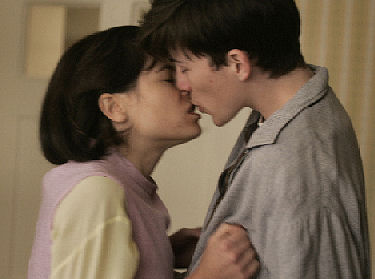 In
the role of the teen Blake, the filmmakers were thrilled when casting
director Priscilla John ‘discovered’ Matthew Beard. Whilst Matthew has
been acting in television and theatre productions since the age of
five, When Did You Last See Your
Father? is his first feature film. Says Anand: “I watched
several audition tapes and Matthew stood out. He moved me! He is a very
intelligent young man and having been through his own family drama, he
showed an ability to really understand the material. He also happens to
be a fine actor and a delightful young man.” Matthew was thrilled to be
offered the part and recognizes the teen Blake he plays in many of his
contemporaries: “He’s a typical teenager—and though he has an
overbearing dad who imposes his opinions—we still get to see them
having a laugh together.”
In
the role of the teen Blake, the filmmakers were thrilled when casting
director Priscilla John ‘discovered’ Matthew Beard. Whilst Matthew has
been acting in television and theatre productions since the age of
five, When Did You Last See Your
Father? is his first feature film. Says Anand: “I watched
several audition tapes and Matthew stood out. He moved me! He is a very
intelligent young man and having been through his own family drama, he
showed an ability to really understand the material. He also happens to
be a fine actor and a delightful young man.” Matthew was thrilled to be
offered the part and recognizes the teen Blake he plays in many of his
contemporaries: “He’s a typical teenager—and though he has an
overbearing dad who imposes his opinions—we still get to see them
having a laugh together.”Rounding out the rest of the Morrison family is Gina McKee as Blake’s wife, Kathy, who says of the project: “It was a beautifully written script, illustrating the relationships in this family in a raw and moving, yet humorous way. I felt a great deal of support for the project and was thrilled to be a part of it.” Claire Skinner fills the role of Gillian, Blake’s sister: “It was a wonderful story—and everybody can relate to it. Having to deal with the extraordinary experience of saying goodbye to a parent, and yet still having to go and get the milk. I think that’s the beauty of it. It deals with the normality of life—and death.”
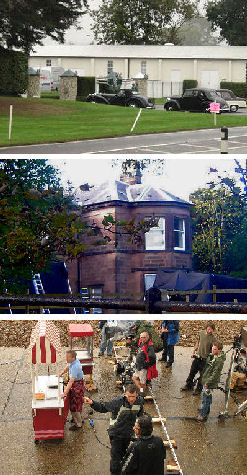
When Did You Last See Your Father? filmed for seven weeks, on location in London, Sussex, and Derbyshire for five weeks, and on sets built at Twickenham Studios for two.
The filmmakers were charged with the enormous task of representing three eras—the 50s, 60s, and 80s—but the shared vision, commitment and talents of the cinematographer Howard Atherton, production designer Alice Normington, costume designer Caroline Harris, and hair and make up designer Christine Blundell has paved the way for a stunning looking film.
Anand has worked with Alice several times before and says: “We have developed a professional shorthand and understand each other”. They sat down together at a very early stage and worked out how they wanted to represent each period. A wealth of photographic reference material provided by Blake Morrison helped inform their designs and ensure a great degree of authenticity.
Locations included London’s Liberal Club for the Awards Ceremony; in Sussex, the famous Goodwood Motor Circuit, where Arthur embarrasses his family by jumping the queue; the picturesque Petworth Park, where child Blake catches Arthur in the car with Beaty; the beautiful West Wittering Beach, where Arthur teaches Blake to drive; and Brighton, for the game of Crazy Golf. Derbyshire locations included two Lodges; Cromford and Weston, which provided the setting for The Grange, home of the Morrison family.
Summing up, David says: “The film is about an ordinary father-son relationship and all the anxieties, pain, embarrassment and emotions of that relationship. The story’s everydayness and extreme frankness will hopefully make it a compelling and emotional experience.”
| Please do
not upload
any images to your own website, club, group or community's photo album. Thank you. |
| Back to Main | Click
on boots to contact me  |